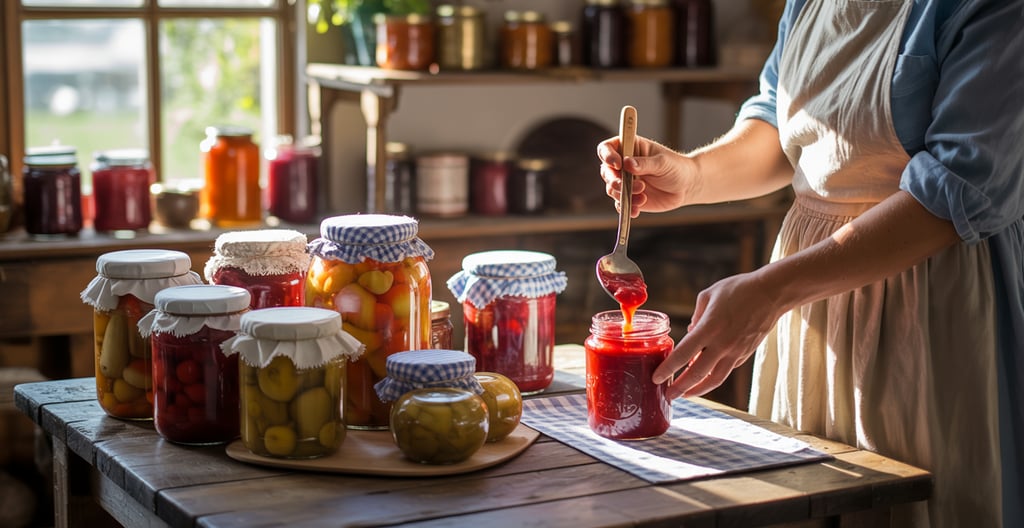How to Prepare and Preserve Fruit Jams and Vegetables for the Winter
As summer fades and autumn approaches, many home cooks and food enthusiasts turn their attention to preserving the season’s abundant harvest. Preparing fruit jams and preserving vegetables for the winter months is a time-honoured tradition that not only captures the flavours of summer but also ensures you have delicious, nutritious foods when fresh produce is scarce. This guide will walk you through the essential steps to safely prepare and preserve fruit jams and vegetables, helping you enjoy your late summer and fall harvest well into the colder months.
7/18/20253 min read


Why Preserve Food for Winter?
Preserving food is a practical way to reduce waste, save money, and maintain a supply of homegrown or locally sourced produce year-round. Proper preservation locks in nutrients and flavours, giving you the taste of summer even when it’s snowing outside. Moreover, making your own jams and preserved vegetables allows you to control ingredients, avoiding preservatives and excess sugars often found in commercial products.
Preparing Fruit Jams: Step-by-Step
Fruit jams are one of the most popular ways to preserve seasonal fruits like strawberries, raspberries, plums, and peaches. Here’s how to prepare and safely preserve them:
1. Selecting Fruit
Choose ripe, high-quality fruit without bruises or signs of mold.
Wash fruit thoroughly under cold running water.
Remove stems, pits, and any damaged parts.
2. Preparing the Fruit
Cut larger fruits into small pieces.
Some fruits benefit from maceration-mixing with sugar and letting them sit to draw out juices and soften.
3. Sugar and Pectin
Sugar acts as a preservative and sweetener.
Commercial pectin helps jam set properly; some fruits (like apples and citrus) naturally contain pectin.
Follow trusted recipes for the right sugar-to-fruit ratio.
4. Cooking the Jam
Combine fruit, sugar, and pectin in a large pot.
Bring to a boil while stirring frequently.
Boil until the mixture thickens and reaches the gel point (usually around 104°C or 220°F). You can test this with a candy thermometer or by placing a small spoonful on a cold plate to see if it gels.
5. Sterilizing Jars
Use glass canning jars with new lids.
Sterilize jars and lids by boiling in water for 10 minutes or running through a dishwasher cycle.
Keep jars hot until ready to fill.
6. Filling and Sealing Jars
Pour hot jam into hot sterilized jars, Leave about 1 cm (approximately 1/4 inch) of headspace when filling jars.
Wipe jar rims clean before sealing.
Screw lids on tightly but not overly tight.
7. Processing Jars
Process filled jars in a boiling water bath for 10–15 minutes to create a vacuum seal.
Remove jars and let cool undisturbed for 12–24 hours.
Check seals: lids should be concave and not flex when pressed.
Preserving Vegetables: Methods and Tips
Preserving vegetables requires careful handling to maintain texture, flavours, and safety. Popular methods include freezing, pickling, and canning.
1. Freezing Vegetables
Wash and peel vegetables as needed.
Blanch vegetables by boiling briefly (time depends on vegetable type) then plunging into ice water to stop cooking.
Drain and dry thoroughly before packing.
Use airtight freezer bags or containers, removing as much air as possible.
Label packages with date and contents.
2. Pickling Vegetables
Select firm, fresh vegetables like cucumbers, carrots, peppers, or green beans.
Wash thoroughly and trim ends.
Prepare brine of vinegar, water, salt, and optional spices.
Pack vegetables tightly into sterilized jars.
Pour hot brine over vegetables, leaving headspace.
Seal jars and refrigerate for quick pickles or process in a boiling water bath for shelf-stable pickles.
3. Canning Vegetables
Use pressure canning for low-acid vegetables (like green beans, carrots, and corn) to prevent botulism.
Follow tested recipes from reliable sources or local extension services.
Sterilize jars and lids before use.
Fill jars, remove air bubbles, and leave proper headspace.
Process jars in a pressure canner at recommended pressure and time.
Let jars cool and check seals.
Important Food Safety Tips
Food preservation requires attention to hygiene and safety to avoid spoilage or foodborne illness.
Always use clean, sterilized equipment and jars.
Use fresh, high-quality produce.
Follow tested recipes exactly for proportions and processing times.
Store preserved foods in a cool, dark place.
Label jars with contents and date.
Inspect jars before use; discard any with broken seals or signs of spoilage.
Storing and Using Your Preserved Foods
Proper storage is key to maximizing shelf life:
Keep jams and canned vegetables in a cool, dry, and dark place.
Refrigerate after opening.
Use home-canned foods within one year for best quality.
Frozen vegetables should be used within 8-12 months.
Rotate stock so older items are used first.
Preserving fruit jams and vegetables for the winter is a rewarding way to extend the joys of summer’s harvest. With careful preparation, attention to safety, and proper storage, you can enjoy the vibrant flavours and nutrition of your garden or local market year-round. Whether you’re a seasoned canner or new to preservation, following these guidelines will help you create delicious, safe, and long-lasting preserves to saver all winter long.
Join us on Pinterest
letstalk@lorybs.com
© 2025. All rights reserved.
